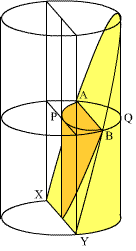Skip over navigation


Or search by topic
Number and algebra
Geometry and measure
Probability and statistics
Working mathematically
Advanced mathematics
For younger learners
Canny Fraction
Age 14 to 16
ShortChallenge Level 





- Problem
- Solutions

Imagine the liquid became solidified.
Rotate the can until the face which contains XY is
horizontal.
Now take the horizontal cross-section half way up the can
which meets the plane face of the "liquid" in the line AB.
Observing that AB bisects the radius PQ, rotate the upper
section of the "liquid" about AB through 180 degrees. The new
position is shaded darkly and fits into the bottom right hand
quarter (with some space to spare).
The actual fraction can be shown to be approximately 0.21. The
answer is therefore less than a quarter.
This problem is taken from the UKMT Mathematical Challenges.
You can find more short problems, arranged by curriculum topic, in our short problems collection.
You may also like
Concrete Calculation
The builders have dug a hole in the ground to be filled with concrete for the foundations of our garage. How many cubic metres of ready-mix concrete should the builders order to fill this hole to make the concrete raft for the foundations?
In a Spin
What is the volume of the solid formed by rotating this right angled triangle about the hypotenuse?

